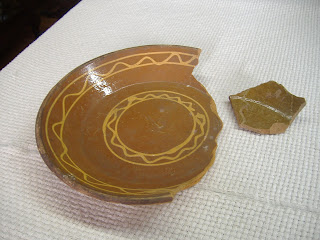 |
| Early New England Pottery |
In Northwest Connecticut and along the western Connecticut shore, potters were influenced by the Dutch and German potters along the Hudson river and Pennsylvania.
 |
| Pie plate by Hervey Brooks |
These potters used slip trailing to make bright patterns on their pots. Hervey Brooks, who I mentioned the other day, lived in Goshen. He made bake ware and dinner dishes... not dinner sets... country folks used common red clay dishes like porringers (soup mugs), water pitchers, chargers (plates), mugs, steins, pie plates, milk pans, pudding bakers, etc.
Pennsylvania potters were more elaborate. They used a technique called sgraffito. A red ware item was coated with white or yellow clay, dried and a pattern was scratched into the surface. They also made some slip trailing that looked like cake decorating today.
 |
| my versions of sgraffito and slip trailing |
Which leads me to today's project. My new slip trays.
In Torringford, the clapboard salt-box style houses were the usual style of building in 1785. Most settlers had come here and build simple log cabins while the new house was being built. There were huge old growth trees back then, plenty of wood to build big roomy houses that were the going style. A house 30'x40' with two stories was not uncommon. Large windows were on every side. One to four brick chimneys and plenty of attic space. An ell was soon added for even more space.
By the time the original house here had burned down, it was replaced by "new" style brick house, a standard 20'x30' two story house, one of six brick houses built in Torringford in the early 1800s. All are still standing, some painted white, and one is now sporting vinyl or aluminum siding.
When Nataniel Birge married Olive Peck and moved into the new brick house on this spot, I am sure he was proud of his sturdy, hansom dwelling. Nathaniel and Olive had three children here, all girls. Janette married and moved nearby, Maryette died here at age 19 from "congestion of the brain", and Martha the youngest, out lived her parents here till she died in 1901.
I assume they ate porridge from red ware porringers, poured fresh milk from red ware pitchures and baked eggy puddings in red ware bakers. The big kitchen fireplace with beehive oven is gone now but the outline can be seen outside on the back wall.
These are my newest slip decorated pieces which will be brighter when glazed and have magnets glued on the back so we can hold photos and little Freddy's drawings on the fridge.
Subscribe to I saved a homestead by Email


No comments:
Post a Comment